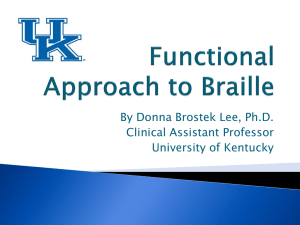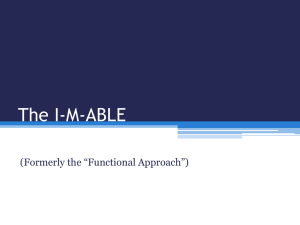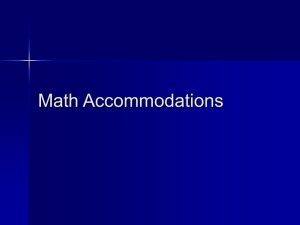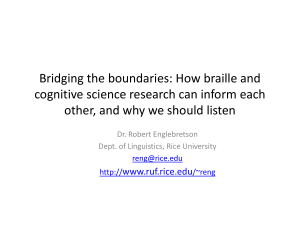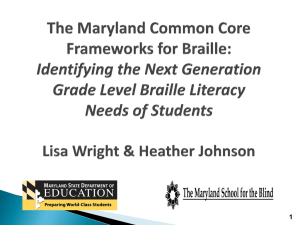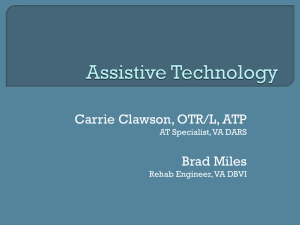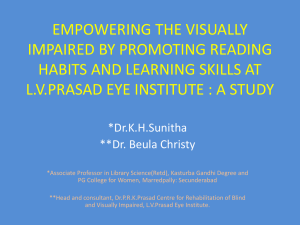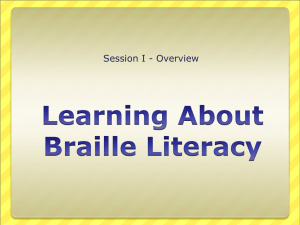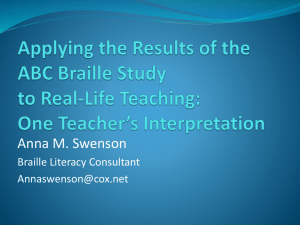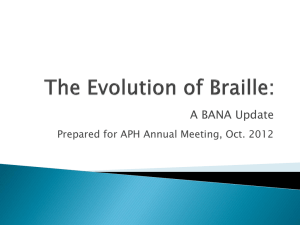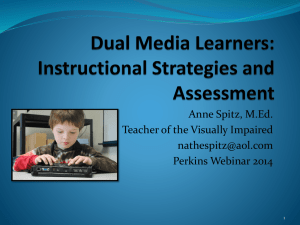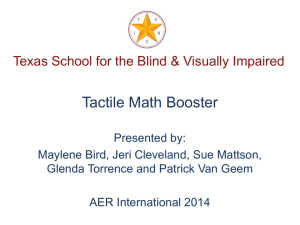Beginning with Braille: Challenges and Choices
advertisement
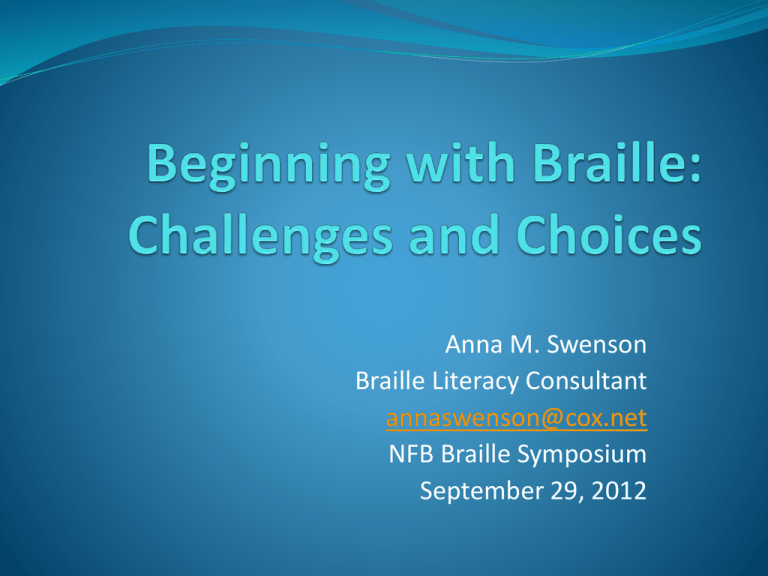
Anna M. Swenson Braille Literacy Consultant annaswenson@cox.net NFB Braille Symposium September 29, 2012 CHALLENGES CHOICES OUTCOMES • Diversity • Emergent Literacy • Curriculum • Inclusion • Assessment • Goals • Setting • Strategies • Learning Activities • Motivation • Engagement • Learning • ECC proficiency Student and Family Teacher of the Visually Impaired Support Staff, Gen. Ed. Teacher and Others Collaboration 3 Road Map … The ABC Braille Study and its implications Choices: Emergent literacy for Braille readers Formal literacy learning: Incorporating Braille instruction into the standard curriculum Questions and discussion To contract or not to contract? That was the question that launched the ABC* Braille Study. Alphabetic Braille and Contracted Braille 5 The Braille Study Research focus: Are there differences in the children’s reading & writing performance based on whether they were initially taught in contracted or uncontracted Braille? Longitudinal study, 2002-2007 Children w/o other disabilities in grades pre-k through 4 Half of teachers started students with contracted Braille, half with uncontracted. (Teachers’ choice) Team of researchers – both qualitative & quantitative data 6 Major Findings Emerson, Holbrook, & D’Andrea, (2009). Acquisition of literacy skills by young children who are blind: Results from the ABC Braille Study “Students [with no additional disabilities] who were introduced to more contractions earlier in instruction performed better on reading measures, such as vocabulary, decoding, and comprehension.” “Students who are blind, regardless of whether they started with contracted or uncontracted Braille, are falling behind their sighted peers and not acquiring reading skills at the rate they should.” 7 Implications for Real-Life Teaching: One Teacher’s Interpretation 1. Teaching the Braille Code 2. The Role of the TVI in Teaching Reading Implications 3. Assessment 4. Literacy Instruction 8 For Preschoolers and Older Students with Additional Learning Challenges 9 Linking Concepts to Literacy: Max’s Home Depot Book Square tile Square of carpet Light switch Outlet and plug Screws and nails (big & little) Chain Tape measure Nuts and bolts (big & little) Piece of wood 10 Interactive Read-Alouds Motivation Concepts Higher Level Thinking Book Language Vocabulary 11 Maximum Meaningful Hands-on Braille Time **Demystify Braille for the other members of the IEP team Model, model, model Encourage early literacy behaviors: pretend reading, scribbling, sounds … 12 Braille Illustrations 13 (Lamb, 1996) A Suggested Approach to Teaching Braille STEP 1 (Controlled, contracted text) PRESCHOOL • Tactile “sight words”, including easy contractions • Familiar names and motivating words STEP 2 PRESCHOOL into KINDERGARTEN • Letters of the alphabet • Numbers • Beginning decoding skills (CVC words) STEP 3 (Uncontrolled, fully contracted text) KINDERGARTEN ON • Contractions taught as they appear in reading materials • More complex decoding skills 14 Motivating Words … 15 It’s a Race! Reading Connected Text 16 What about the dots of the Braille cell? “Sadie and I talked about how the Y has a head, a body and feet. Then she said, ‘but it doesn't have a belly’. I loved that, and of course I went on about what a smart observation that was!” 17 Benefits of Braille Instruction for Non-Traditional Learners Oral language, vocabulary, communication skills development Functional uses, e.g. Labeling belongings or items used in pre-vocational tasks Development of independent work skills Socialization: e.g., games / sharing books General knowledge of gen. ed curriculum Stepping stone to formal academic instruction 18 I-M-ABLE (Dr. Diane Wormsley) Individualized Meaning-centered Approach to Braille Literacy Education Student-centered: Totally individualized and highly motivating Appropriate for wide range of learners Key words of interest to the learner = basis for instruction (i.e., phonics, spelling, reading connected text all taught with key words) Whole to part approach: “Language of Touch” Contractions taught from the beginning Resources: Book and articles 19 Incorporating Braille instruction into the standard curriculum 20 The Balancing Act INCLUSION INDIVIDUAL INSTRUCTION Talk about books Work on the Braille code Share writing within the context of reading instruction Preview classroom activities, e.g., book for reading group Address goals and objectives related to the Expanded Core Curriculum Participate in reading group Learn classroom behaviors necessary to function as part of a group, including independent work habits Develop social skills 21 Considerations … • What is the child’s performance level in each area of literacy? (based on Gen ed and Braille-specific assessments) • Am I providing sufficient service time to allow flexibility in when I choose to work with the child individually? • Would a greater amount of pull-out now make more inclusion possible later on? • Based on on-going data collection, should I consider changing the balance? 22 FIVE TIPS FOR FACILITATING INCLUSION 23 1. Prioritize positive collaboration with classroom teachers The “ownership” challenge Step back (19 Ways) Reassure teachers about visual assignments Set high expectations from the beginning (video) Be sensitive to the multiple demands on classroom teachers’ time and plan contacts strategically Contribute to the learning of other children in the class Assess and evaluate the student’s progress together Listen to classroom teachers’ concerns 24 3. Take advantage of instructional materials that facilitate inclusion Word PlayHouse Early Braille Trade Books http://tech.aph.org/ebt/ 25 4. Promote independent work habits Beware of “learned helplessness” Step back Start during individual instruction Preview assignments Teach organizational skills 26 Temporary (Invented) Spelling 27 5. Advocate for technology Expand children’s access to a wide variety of devices Solve the Computer Lab dilemma Let our students join the 21st century! 28 Continuing the discussion … How can we provide TVIs with the background in literacy instruction they need to teach children who are learning to read in Braille? In response to the results of the ABC Braille Study, how can we improve literacy outcomes for our Braille readers? What factors contribute to successful inclusion for students who read Braille? How do we encourage parents to become involved in their children’s concept development and literacy learning? (including learning Braille) How can we get technology into the hands of our younger learners? What is the optimum balance between paper-based and paperless Braille devices for beginning Braille students? How do we meet the literacy needs of potential Braille students who are non-traditional learners? 29
